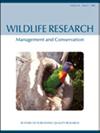影响澳大利亚东部四个地点野猪(Sus scrofa)活动范围的因素
IF 1.6
3区 生物学
Q3 ECOLOGY
引用次数: 0
摘要
本文章由计算机程序翻译,如有差异,请以英文原文为准。
Factors influencing the activity ranges of feral pigs (Sus scrofa) across four sites in eastern Australia
ABSTRACT Context. Understanding the home-range size and the ecological drivers that influence the spatial distribution of feral pigs is of paramount importance for exotic-disease modelling and the improvement of pest management programs. Aims. To investigate various factors affecting home- and core-range size and test selection of habitat, to better inform disease modelling and pest management programs. Methods. In this study, 59 GPS-collared feral pigs were tracked over four sites in eastern Australia between 2017 and 2021. Using minimum convex polygon (MCP) and the nearest-neighbour–local convex hull (k-LoCoH) as home-range estimators and foliage projective cover (FPC) as an estimator of landscape-scale shelter, we investigated the influence of sex, site, season, year and body weight on range size and tested selection of habitat by using chi-squared and Jacob’s index tests. Key results. Home-range sizes were highly variable, with k-LoCoH90 (home) ranges between 0.08 and 54.97 km2 and k-LoCoH50 (core) ranges between 0.01 and 7.02 km2. MCP90 ranged between 0.15 and 242.30 km2, with MCP50 being between 0.07 and 60.61 km2. Sex and site both significantly (P < 0.001) influenced home-range size, but season and year did not. Home-range size was shown to increase with body mass for both sexes (P = 0.001). Importantly, the data indicated that feral pigs prefer habitat within 20–40% FPC (woodland), whereas open forests (51–80% FPC) and closed forests (>80% FPC) were actively avoided. Typically, use of open vegetation (1–10% FPC) was also avoided, but this behaviour varied and was dependent on site. Conclusion Feral pig ranges are influenced by sex, site and body mass but not by season and year. Broad-scale selection for shelter indicated that feral pigs prefer habitat between 20% and 40% FPC. Implications. Targeting or avoiding such areas respectively for control or monitoring tool placement may result in improved, efficient outcomes to monitor or manage feral pig populations. Feral pig distribution modelling may also find benefit in the consideration and further study of the above factors and the influence of food and water sources on the activity ranges and behaviour of feral pigs.
求助全文
通过发布文献求助,成功后即可免费获取论文全文。
去求助
来源期刊

Wildlife Research
生物-动物学
CiteScore
4.30
自引率
15.80%
发文量
56
审稿时长
3 months
期刊介绍:
Wildlife Research represents an international forum for the publication of research and debate on the ecology, management and conservation of wild animals in natural and modified habitats. The journal combines basic research in wildlife ecology with advances in science-based management practice. Subject areas include: applied ecology; conservation biology; ecosystem management; management of over-abundant, pest and invasive species; global change and wildlife management; diseases and their impacts on wildlife populations; human dimensions of management and conservation; assessing management outcomes; and the implications of wildlife research for policy development. Readers can expect a range of papers covering well-structured field studies, manipulative experiments, and analytical and modelling studies. All articles aim to improve the practice of wildlife management and contribute conceptual advances to our knowledge and understanding of wildlife ecology.
Wildlife Research is a vital resource for wildlife scientists, students and managers, applied ecologists, conservation biologists, environmental consultants and NGOs and government policy advisors.
Wildlife Research is published with the endorsement of the Commonwealth Scientific and Industrial Research Organisation (CSIRO) and the Australian Academy of Science.
 求助内容:
求助内容: 应助结果提醒方式:
应助结果提醒方式:


